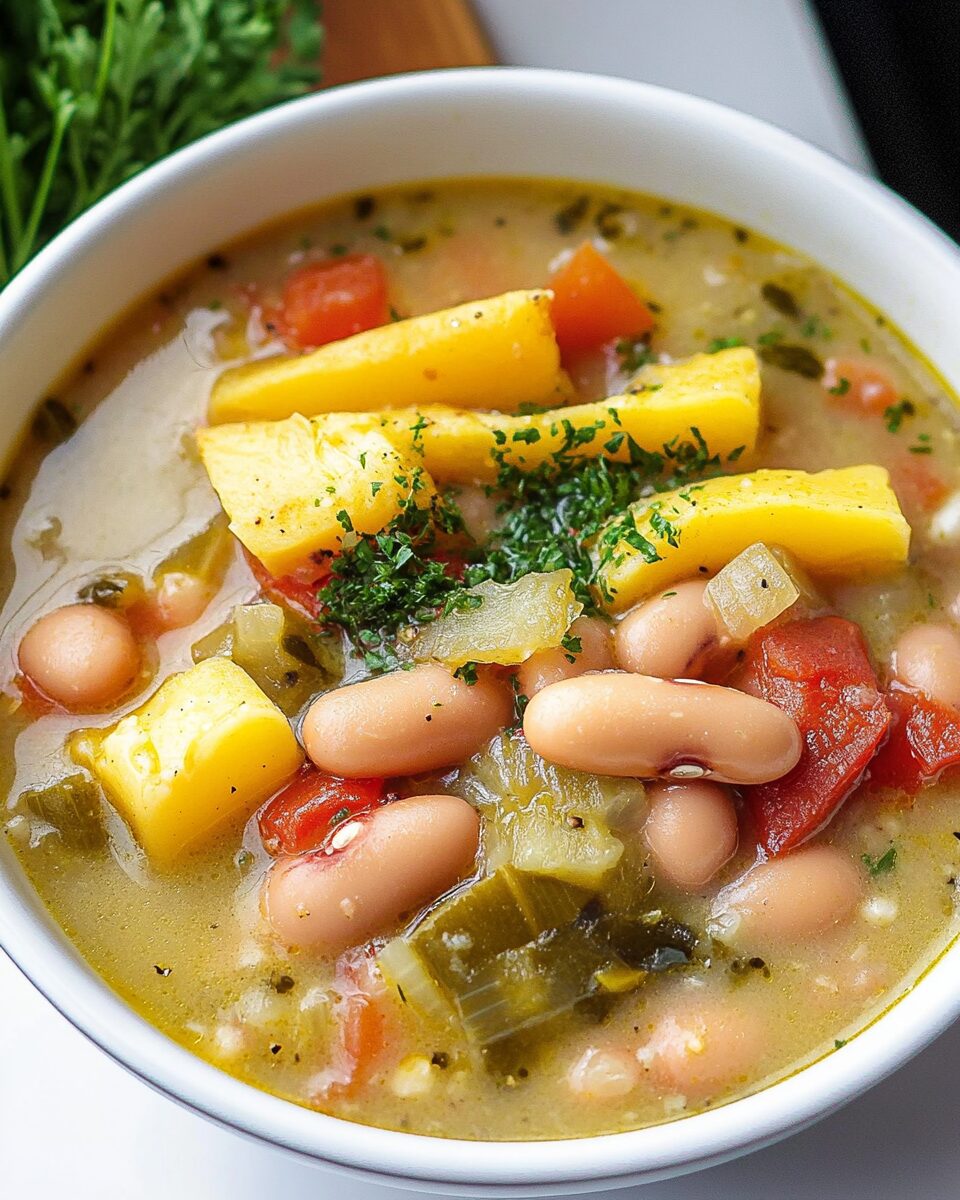The German Bean Soup is a true classic from the heart of European home kitchens. With white beans simmered alongside smoked sausage, root vegetables, and aromatic herbs, this one-pot dish offers both depth of flavor and heartwarming satisfaction. It’s the perfect choice for chilly evenings, offering the kind of comfort only a slow-simmered soup can deliver.
Not only is it deeply flavorful and filling, but it’s also incredibly easy to make with pantry staples. Whether served with crusty bread or as a standalone dish, this traditional German soup showcases how humble ingredients can be transformed into a soul soothing meal. Each spoonful carries a hint of smokiness and herbal warmth, making it a go-to for lovers of rustic, hearty dishes.
Full Recipe:
Ingredients:
-
2 tbsp olive oil
-
1 medium onion, chopped
-
2 cloves garlic, minced
-
2 medium carrots, diced
-
2 celery stalks, diced
-
2 medium potatoes, peeled and cubed
-
200g smoked sausage, sliced
-
400g canned white beans, drained and rinsed
-
1 bay leaf
-
1/2 tsp dried marjoram
-
1/2 tsp ground black pepper
-
Salt to taste
-
1 liter vegetable or chicken broth
-
Fresh parsley for garnish
Directions:
-
Heat olive oil in a large pot over medium heat.
-
Add the chopped onions and garlic and sauté until translucent, about 2-3 minutes.
-
Add the diced carrots, celery, and potatoes. Stir and cook for 4-5 minutes.
-
Toss in the sliced smoked sausage and cook for another 3-4 minutes to lightly brown.
-
Pour in the broth and add the white beans, bay leaf, marjoram, pepper, and salt.
-
Bring to a boil, then reduce heat and let it simmer for 25-30 minutes, or until the vegetables are tender.
-
Remove the bay leaf, adjust seasoning if needed.
-
Garnish with fresh parsley before serving.
Prep Time: 10 minutes | Cooking Time: 35 minutes | Total Time: 45 minutes
Kcal: 310 kcal | Servings: 4 servings
German Bean Soup A Traditional Comfort Dish with Deep Cultural Roots
When it comes to classic, comforting European dishes, few can rival the simple yet satisfying qualities of German Bean Soup. Known for its hearty ingredients, depth of flavor, and nutritional richness, this rustic soup is a staple in many German households, especially during the colder months. Though the ingredients are humble beans, vegetables, herbs, and broth the final product is a warming, deeply flavored dish that speaks to centuries of culinary tradition and seasonal eating.
This isn’t just any bean soup it’s a dish steeped in history, adapted over generations, and embraced in nearly every region of Germany. From the hearty peasant versions of Bavaria to the lighter, broth based varieties found in the northern regions, Bohnensuppe (as it’s called in German) has long been a symbol of frugality, nutrition, and comfort.
Historical and Cultural Significance of German Bean Soup
German Bean Soup has its roots in agricultural communities where legumes were a dietary staple due to their affordability, long shelf-life, and protein content. Dried beans were often stored for winter and used in soups that also incorporated root vegetables like potatoes, carrots, and leeks ingredients that were readily available even during the lean months.
In post-war Germany, bean soup was a common meal, not only for its nutritional value but also for its economy. It became a way to stretch a few ingredients into a nourishing family meal. Over time, it evolved from necessity into a beloved comfort food, often associated with home-cooked meals, grandmother’s kitchen, and the kind of warmth that only comes from a slow-simmered pot on the stove.
Today, German Bean Soup is still deeply appreciated, not only in Germany but in kitchens around the world that value nutritious, filling meals with a European flair.
Regional Variations Across Germany
Like many traditional dishes, there’s no one “correct” way to make German Bean Soup. Instead, it morphs depending on regional preferences and available ingredients.
-
Southern Germany (Bavaria and Swabia): These areas favor richer versions of the soup, sometimes made with speck (smoked pork), sausages like Wiener or Landjäger, or even bits of ham hock. The flavors are robust, and the soup is often thickened with a roux or mashed potatoes.
-
Northern Germany: Soups here are typically lighter, focusing more on broth and fresh vegetables. Northern versions may use white beans more sparingly and highlight herbs like marjoram and parsley.
-
East Germany (former DDR): In the former East Germany, bean soup was frequently made using canned goods, a practical adaptation during times of limited access to fresh ingredients. It was often served with rye bread or sourdough.
These regional takes only add to the allure of the dish, giving it the flexibility to be tailored to personal preferences or pantry limitations.
Nutrition and Health Benefits
One of the reasons German Bean Soup has remained a culinary mainstay is its incredible nutritional profile. It is naturally high in protein and fiber thanks to the beans, which also make the soup filling and energy-sustaining.
Carrots, leeks, celery, and potatoes add a range of vitamins and minerals, while herbs like marjoram provide anti-inflammatory benefits. The soup can be easily modified to be vegetarian or vegan by using vegetable broth and omitting any meat products, making it an inclusive dish suitable for many diets.
Some of the key health benefits include:
-
Heart Health: Beans are rich in soluble fiber and plant-based proteins, both of which support cardiovascular wellness.
-
Digestive Support: The high fiber content helps regulate digestion and promote gut health.
-
Immune Boosting: The vegetables and herbs used in this soup are full of vitamins A, C, and K, which support immune function.
-
Weight Management: Its high fiber and protein content help with satiety, making it a great option for those looking to manage their weight naturally.
Plus, it’s free from processed ingredients and relies on whole foods, making it a smart choice for clean eating.
Flavor Profile and Customization Options
At its core, German Bean Soup balances sweet earthiness from carrots and leeks with the creamy texture of beans and the grounding base of a good broth. Herbs like marjoram or thyme add warmth and aroma, while optional additions like bacon or sausage introduce smoky depth and richness.
One of the most attractive features of this soup is its adaptability. Here are a few common variations and add-ins:
-
Smoked Sausage or Bacon: For a meatier version, try adding sliced sausage or chopped bacon at the beginning of the cooking process.
-
Different Beans: While white beans are traditional, you can experiment with kidney beans, pinto, or even lentils.
-
Grains: Add barley, farro, or rice for extra bulk and texture.
-
Leafy Greens: Stir in kale, spinach, or cabbage toward the end of cooking for added nutrition.
-
Spices: Customize the spice profile with a pinch of chili flakes or smoked paprika for a modern twist.
This flexibility allows home cooks to make the dish their own while maintaining its core identity.
Serving Suggestions
German Bean Soup is best served piping hot with a slice of hearty bread rye, sourdough, or whole wheat are all excellent choices. A drizzle of olive oil or a small dollop of sour cream on top can add richness and an appealing finish.
For a more traditional presentation, pair the soup with:
-
Pretzels (Brezn)
-
Rye Rolls (Roggenbrötchen)
-
A side of sauerkraut or pickles, which offer a nice contrast with the creamy, mild soup
A mug of dark German beer or apple cider also pairs wonderfully with this dish, especially if you’re serving it for dinner.
Why You Should Try German Bean Soup
If you’re looking for a meal that is warming, economical, nutrient-dense, and endlessly adaptable, German Bean Soup is an excellent choice. Whether you’re a seasoned home cook or just starting out, this dish offers a forgiving recipe structure with high rewards in flavor and comfort.
It’s also ideal for:
-
Meal prepping: It stores and reheats beautifully.
-
Family meals: It’s easy to double or triple.
-
Entertaining: Serve it in rustic bowls with toppings and bread sides for a cozy dinner party.
For those who appreciate cooking with intention and creating dishes that nourish both body and soul, German Bean Soup is a timeless go-to.
Conclusion:
German Bean Soup exemplifies everything that’s wonderful about traditional European cooking: simplicity, seasonality, and soul. While it may have originated as a peasant dish, it has earned its place as a beloved staple in modern kitchens worldwide.
The soup’s charm lies not only in its satisfying taste but also in its rich history and cultural legacy. It invites us to slow down, appreciate the art of simmering a pot of vegetables and beans, and enjoy the warmth it brings to our tables and hearts.
Whether you’re trying it for the first time or bringing back a childhood favorite, German Bean Soup is a recipe worth keeping in your regular rotation easy to prepare, rewarding to eat, and always comforting.






